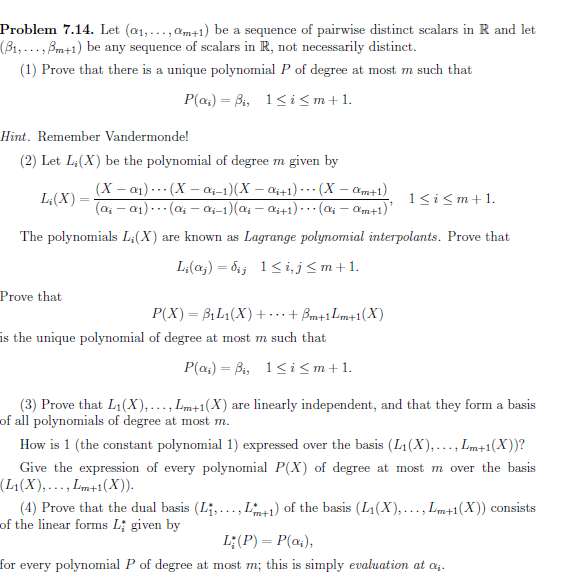Problem 7.14. Let (æ1,...,am+1) be a sequence of pairwise distinct scalars in R and let (B1,...,Bm+1) be any sequence of scalars in R, not necessarily distinct. (1) Prove that there is a unique polynomial P of degree at most m such that P(a4) Bi, 1i
Problem 7.14. Let (æ1,...,am+1) be a sequence of pairwise distinct scalars in R and let (B1,...,Bm+1) be any sequence of scalars in R, not necessarily distinct. (1) Prove that there is a unique polynomial P of degree at most m such that P(a4) Bi, 1i
Linear Algebra: A Modern Introduction
4th Edition
ISBN:9781285463247
Author:David Poole
Publisher:David Poole
Chapter4: Eigenvalues And Eigenvectors
Section4.2: Determinants
Problem 16AEXP
Related questions
Question
Hello, kindly assist me with the solution to Q3. I will appreciate it if you provide a very detailed solution, thanks

Transcribed Image Text:Problem 7.14. Let (æ1,...,am+1) be a sequence of pairwise distinct scalars in R and let
(B1,...,Bm+1) be any sequence of scalars in R, not necessarily distinct.
(1) Prove that there is a unique polynomial P of degree at most m such that
P(a4) Bi, 1i <m+1.
Hint. Remember Vandermonde!
(2) Let Li(X) be the polynomial of degree m given by
(X - a1)(X- a1-1)(X -a441) (X -am+1)
(a-a1)(a- ai-1)(a-ai+1)
1 im
L&(X)
(a4-am+1)
The polynomials L'(X)
Lagrange polynomial interpolants. Prove that
are known as
Li(aj) 6 1 i,j <m+1
Prove that
Bm+1 Lm+1(X)
Р(X) — BiL1(X) +
is the unique polynomial of degree at most m such that
P(a4) Bi, 1< i <m+1
(3) Prove that L1(X),..., Lm+1(X) are linearly independent, and that they form a basis
of all polynomials of degree at most m
How is 1 (the constant polynomial 1) expressed
over the basis (L1(X),..., Lm+1(X) )?
Give the expression of every polynomial P(X) of degree at most m over the basis
(L1(X), ...,m+1(X)
(4) Prove that the dual basis (Li, ..., L1)of the basis (L1(X),..., Lm+1(X)) consists
of the linear forms L given by
L;(P) P(a)
for every polynomial P of degree at most m; this is simply evaluation at a
Expert Solution
This question has been solved!
Explore an expertly crafted, step-by-step solution for a thorough understanding of key concepts.
This is a popular solution!
Trending now
This is a popular solution!
Step by step
Solved in 6 steps with 6 images

Knowledge Booster
Learn more about
Need a deep-dive on the concept behind this application? Look no further. Learn more about this topic, advanced-math and related others by exploring similar questions and additional content below.Recommended textbooks for you

Linear Algebra: A Modern Introduction
Algebra
ISBN:
9781285463247
Author:
David Poole
Publisher:
Cengage Learning

Algebra & Trigonometry with Analytic Geometry
Algebra
ISBN:
9781133382119
Author:
Swokowski
Publisher:
Cengage

Linear Algebra: A Modern Introduction
Algebra
ISBN:
9781285463247
Author:
David Poole
Publisher:
Cengage Learning

Algebra & Trigonometry with Analytic Geometry
Algebra
ISBN:
9781133382119
Author:
Swokowski
Publisher:
Cengage